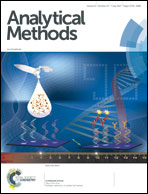A bispyrene/AgNP-based ratiometric nanoprobe for supersensitive fluorescence and colorimetric sensing of etimicin†
Abstract
A new ratiometric nanosystem has been developed for selective and ultrasensitive detection of etimicin based on citrate-stabilized silver nanoparticles (AgNPs) and N,N′-bis-(1-pyrenecarboxaldehyde)-1,12-dodecanediamine (probe 1). Probe 1, a bispyrene Schiff base derivative, was designed to function as an ideal dual-emission fluorophore because of its special monomer and excimer bands at around 396 and 483 nm, respectively. Meanwhile, AgNPs can serve as an excellent light-absorber as well as a colorimetric probe. In the presence of etimicin, the fluorescence intensity at 396 nm increases owing to the turn-on of the fluorescence of probe 1. Moreover, etimicin can induce the aggregation of AgNPs and subsequently enhance the emission quenching of probe 1 at 483 nm due to the restriction of the conformational change of bispyrene molecules, thus leading to the corresponding ratiometric fluorescence measurement of the analyte. Additionally, analyte-caused aggregation of AgNPs also favors ratiometric colorimetric detection of etimicin. Under the optimum conditions, this convenient ratiometric nanosensor can be applied to the fluorescence and colorimetric analysis of etimicin in human urine with the detection limit as low as 0.05 and 0.25 nM (S/N = 3), respectively.



 Please wait while we load your content...
Please wait while we load your content...